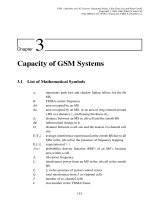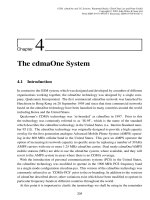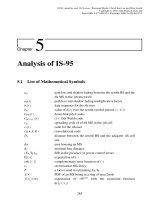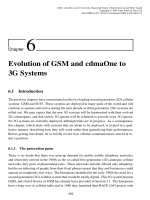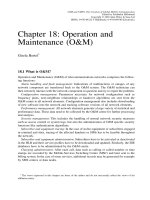Tài liệu GSM and UMTS (P19) pptx
Bạn đang xem bản rút gọn của tài liệu. Xem và tải ngay bản đầy đủ của tài liệu tại đây (142.78 KB, 11 trang )
Chapter 19: Professional
Technical Support and its
Evolution
Section 1: The Permanent Nucleus in the CEPT
Environment
Bernard Mallinder
1
During late 1985 the CEPT Groupe Spe
´
cial Mobile (GSM) decided that in the interest of
maintaining speed and quality in the development of the technical recommendations, a
central support function was required. The mandate for this unit was agreed in early 1986
and the ‘‘Permanent Nucleus’’ (PN) of the GSM was created. The approach and mandate of
the unit built on the successful experience that the CEPT had had in the rapid development of
specifications for both satellite and ISDN services. The unit was established in Paris during
the summer of 1986 and consisted of full-time technical managers and programme managers.
The PN had expert full-time resources from France, Germany, Sweden, Norway, Finland,
Holland, Switzerland and the UK.
The initial tasks involved supporting the working group chairpersons, ensuring technical
consistency, documentation release control, consolidation of work-plans and reporting
progress to the plenary of GSM. Within a year the role of the PN extended to the creation
of the equipment specifications (11 Series) and the formulation of the network management
recommendations (12 Series). In addition, the PN was charged with the co-ordination of the
evaluation of the different candidate technologies for the radio interface. These tests were
undertaken by CNET in Paris and involved the evaluation of TDMA and CDMA offerings.
After the choice for TDMA with slow frequency hopping, GSM entered into a review of
the complexity of the complete system. Initial work undertaken by Televerket in Sweden
indicated that the layer 3 protocol on the air interface resulted in an extensive acquisition time
during the initial ‘‘turn-on’’ period. The ‘‘Complexity Review’’ commenced during late 1987
and continued until the spring of 1988. During this period all working groups contributed and
a number of review meetings were co-ordinated by the PN in Paris. The findings and
suggested improvements were tested and examined in various centres including CNET in
France, FTZ in Germany, CSELT in Italy, BT and Racal Research in the UK. As a result of
1
The views expressed in this chapter are those of the author and do not necessarily reflect the views of his
affiliation entity.
GSM and UMTS: The Creation of Global Mobile Communication
Edited by Friedhelm Hillebrand
Copyright q 2001 John Wiley & Sons Ltd
ISBNs: 0-470-84322-5 (Hardback); 0-470-845546 (Electronic)
this work a catalogue of ‘‘simplifications’’ was formulated and approved by GSM. The first
drafts of the complete recommendations (Series 1-12) were made available to participating
parties by the summer of 1988.
In parallel with the ‘‘ Complexity Review’’ the PN was charged with evaluating the indus-
trial challenges involved in the design and manufacture of future handsets. This work was
principally supported by industry experts who were in a position to create ‘‘ top-down-design’’
of complete handsets. Fabrication of the logical functions, the RF entities, casing and battery
technologies were considered. Assumptions were constructed concerning the availability of
sub-micron technologies, yield rates of new chipsets and performance of external and inte-
grated antennae. The input from this study placed additional pressure on the need to reduce
complexity to ensure that the price, weight and performance targets for the handsets could be
achieved.
During the evaluation of the early radio interface proposals GSM began to consider the
possible impact of intellectual property on the development of the system. Ideas concerning
‘‘ cross’’ and ‘‘ pooled’’ licensing were considered. There was however a need to identify
relevant patents and to consolidate a list of ‘‘ vital’’ patents. The PN was charged with the
task and Patent Review Group consisting of network operators and manufactures was active
during 1987. At the end of the process some 22 previous patents were identified as ‘‘vital’’ .
Some of these belonged to operators and others to vendors. Numerous initiatives followed the
identification of the patents. Members of the GSM group then sought to secure commercial,
political and/or technical solutions to the patents.
As the definition of the GSM system stabilised interest in the system began to develop.
Various conferences emerged as did requests for technical papers and workshops. Members
of the PN were invited to numerous technical presentations and discussions. The important
points which needed to be communicated were the progress of the technical work, innovative
services, interworking with ISDN and data networks, coverage techniques and the functional
architecture. Less technical areas were also addressed including specification methodology,
consistency management, release control and eventually system performance.
GSM and UMTS: The Creation of Global Mobile Communication452
Chapter 19: Professional
Technical Support and its
Evolution
Section 2: PT12 and PT SMG in the ETSI
Environment
Ansgar Bergmann
1
When, in 1989, ETSI was created, GSM became a technical committee of ETSI, and the
Permanent Nucleus (PN) was transformed to become ETSI Project Team 12 (PT12). Some
time later, at the end of 1991, the offices were moved from Paris to the ETSI premises in
Sophia Antipolis.
Between 1989 and 2000, PT12 and later PT SMG continued the work of the PN to perform
the project management for the Technical Committee GSM and later SMG, to maintain
overall aspects of the specifications such as quality, consistency and compatibility, to support
working parties of GSM/SMG and to perform specific tasks including specification work. In
this period, GSM grow up with breathtaking speed, in terms of users, of countries to introduce
GSM, of networks, of variety of services offered to the users and of applicable frequency
bands, and the GSM core network became the de facto standard platform to connect other
radio access technologies.
PT12 was financed from the ETSI funded work program, and there was additional specific
funding from the EC, from GSM MoU Group/Association (later GSM Association), and from
member companies. This additional funding was often related to specific tasks and deliver-
ables. For the sake of bookkeeping, separate project teams were installed for these specific
tasks. However, all these project teams were managed in one integrated structure, and
‘‘PT12’’ was used as a generic term for the varying number of tasks.
Until 1995, PT12 was responsible for GSM only, and did not support the UMTS devel-
opment within SMG. In 1996, ETSI agreed, on proposal of SMG, to assign project team
support to UMTS in order to push the development. The new PT83 was integrated with PT12
as well, and to give things better visibility, the integrated team was named PT SMG.
1
The views expressed in this section are those of the author and do not necessarily reflect the views of his affiliation
entity.
GSM and UMTS: The Creation of Global Mobile Communication
Edited by Friedhelm Hillebrand
Copyright q 2001 John Wiley & Sons Ltd
ISBNs: 0-470-84322-5 (Hardback); 0-470-845546 (Electronic)
19.2.1 Consolidation of GSM Phase 1
In the years 1989–1992, the main focus of activities in GSM and PT12 was the consolidation
of phase 1 specifications in order to enable the roll-out of the GSM system and the availability
of mobile stations.
An important milestone was the edition of Release 90 phase 1 specifications. For monitor-
ing the status of specifications and to trace all changes, PT12 had established a Change
Request (CR) procedure. At GSM#25, this procedure was further improved
2
and it was
decided to go on with two parallel series, the phase 1 and phase 2 specifications, cf. Section
17 on working methods. The scope of phase 1 and 2 was defined by GSM MoU.
PT12 also led two expert groups:
†
PT12-OMEG, the Operation and Maintenance Experts Group, which was transformed in
1992 into the technical subcommittee SMG6 of SMG;
†
PT12-ES
3
, responsible for the test specifications for the mobile station and the base station
sub-system; in 1994, it was transformed into two SMG subcommittees, SMG7 (mobile
station testing) and SMG8 (BSS testing).
Free circulation of mobile stations was one of the essential goals of GSM. Mobile stations
had to work correctly and with good quality in any GSM network. This explains the impor-
tance of the mobile station type approval regime. PT12 took an essential role, in cooperation
with other groups including
†
Type Approval Advisory Board (TAAB) and its successor organisations;
†
GSM MoU;
†
ECTEL-TMS;
†
EU organisations such as TRAC and ACTE.
The interim type approval, then the full type approval was installed. Later, the transition to
the new legal scheme defined by the EC, the CTR/TBR regime, had–be managed, and with a
tremendous effort, GSM was the first–implement the CTR/TBR regime. See also Sections 14
and 17.2.
In 1990, GSM became responsible for standardizing DCS1800, at that time also known as
Personal Communication Networks (PCN). It was agreed to specify DCS 1800 as a version of
GSM in the 1800 band. In phase 1, there were delta specifications for DCS 1800, mainly
concerning adaptation of radio transmission parameters, but also necessary consequences of
the added frequency band for signalling, testing, the SIM card, cell selection and network
selection, and special requirements of the DCS 1800 operators for equipment sharing and
national roaming. The DCS 1800 activities were supported by experts working in an exten-
sion of PT12, funded by interested parties (the PCN operators).
19.2.2 Introduction of GSM Phase 2
The need to introduce GSM in phases had already been recognized before 1990. Some
features had been deferred rather early to phase 2, for example:
GSM and UMTS: The Creation of Global Mobile Communication454
2
Cf. TDoc P-482/89 rev2.
3
ES stands ‘‘ Eleven Series’’ : the MS and BSS test specifications were 11.10 and 11.20.
†
some services, in particular supplementary services;
†
radio resource management functions as the pseudo-synchronous handover.
(Some features like facsimile, data services and the half-rate speech codec were moved
later to phase 2 due to technical difficulties arising.) Accordingly, the GSM working parties
had started already in 1989 to elaborate and agree phase 2 change requests, however the GSM
plenary had in principle postponed phase 2 approvals until meeting #30 in 1991. This way of
proceeding had the advantage that
†
work concentrated on getting phase 1 working; and
†
a more complete picture of phase 2 was achieved before detailed technical decisions were
taken.
It had the disadvantage, however, that for some considerable time, phase 2 change requests
were prepared in the working parties on a moving basis – changing versions of the phase 1
specifications – a fact leading to several clashes and contradictions. Whence, a consolidation
phase became necessary to establish the platform for phase 2. A major part of this work was
performed by PT12 and the rapporteurs of specifications.
Other activities demanding high support by PT12/PT SMG related to
†
the merging of GSM 900 and DCS1800 specifications;
†
phase 2 mobile station type approval, including the creation of phase 2 TBRs and the
translation of tests into the formal test description language TTCN.
19.2.3 The Evolution of GSM Phase 21
In 1995, the phase 2 specifications were frozen as version 4.x.y. The further evolution of
GSM took place as phase 21 (cf. Section 20), the basic concept being to add new features as
options. Depending on the completion date of specifications, features were assigned to yearly
releases R96, R97 and so on.
With a slightly increased number of experts, PT SMG started to provide support to all
SMG Sub-Technical Committees (STCs; the number had grown from 4 to 11; earlier, some
STCs did not have PT SMG support) and almost all working groups.
There was substantial discussion about the appropriate way to document the evolving GSM
system in the standard, and it was then decided to create a parallel new complete set of
specifications for each release.
PT SMG expanded the project management, a roadmap was created to reflect the progress
of each work item, and this roadmap was derived from a work item database maintained by
PT SMG. For bigger work items, work item managers were nominated and project descrip-
tion documents were created in the 10.xy series.
With the increase of participating companies, the introduction of electronic document
handling became more and more important. SMG started to provide all meeting documents
in electronic form and made them available on CD-ROM; step by step, the meetings went
from paper documents to electronically only distributed documents, and today all ETSI and
3GPP specifications and meeting documents are available on the Web (www.etsi.org and
www.3GPP.org), much work is done in e-mail discussion groups, and meetings use LANs for
the document handling.
Chapter 19: Professional Technical Support and its Evolution 455





